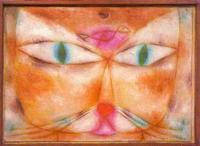 humorous works are replete with allusions to dreams, music, and poetry, Paul Klee is difficult to classify. Primitive art, surrealism, cubism, and children's art all seem blended into his small-scale, delicate paintings, watercolors, and drawings.
humorous works are replete with allusions to dreams, music, and poetry, Paul Klee is difficult to classify. Primitive art, surrealism, cubism, and children's art all seem blended into his small-scale, delicate paintings, watercolors, and drawings.Klee grew up in a musical family and was himself a violinist. After much hesitation he chose to study art, not music, and he attended the Munich Academy in 1900. There his teacher was the popular symbolist and
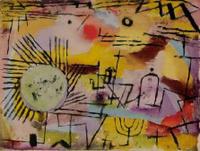 society painter Franz von Stuck. Klee later toured Italy (1901-02), responding enthusiastically to Early Christian and Byzantine art.
society painter Franz von Stuck. Klee later toured Italy (1901-02), responding enthusiastically to Early Christian and Byzantine art.Klee's early works are mostly etchings and pen-and-ink drawings. After his marriage in 1906 to the pianist Lili Stumpf, Klee settled in Munich, then an important center for avant-garde art. That same year he
 exhibited his etchings for the first time. His friendship with the painters Wassily Kandinsky and August Macke prompted him to join Der Blaue Reiter (The Blue Rider), an expressionist group that contributed much to the development of abstract art.
exhibited his etchings for the first time. His friendship with the painters Wassily Kandinsky and August Macke prompted him to join Der Blaue Reiter (The Blue Rider), an expressionist group that contributed much to the development of abstract art. 
A turning point in Klee's career was his visit to Tunisia with Macke and Louis Molliet in 1914. He was so overwhelmed by the intense light there that he wrote: "Color has taken possession of me; no longer do I have to chase after it, I know that it has hold of me forever. That is the significance of this blessed moment. Color and I are one. I am a painter." He now built up compositions of colored squares
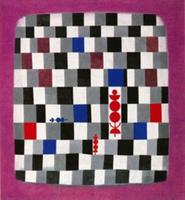 that have the radiance of the mosaics he saw on his Italian
that have the radiance of the mosaics he saw on his Italian 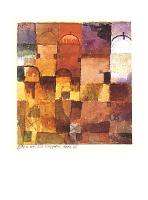 sojourn. The watercolor Red and White Domes (1914; Collection of Clifford Odets, New York City) is distinctive of this period.
sojourn. The watercolor Red and White Domes (1914; Collection of Clifford Odets, New York City) is distinctive of this period.Klee often incorporated letters and numerals into his paintings,
 as in Once Emerged from the Gray of Night (1917-18; Klee Foundation, Berlin). These, part of Klee's
as in Once Emerged from the Gray of Night (1917-18; Klee Foundation, Berlin). These, part of Klee's 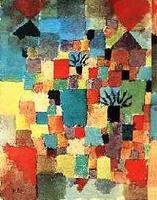 complex language of symbols and signs, are drawn from the unconscious and used to obtain a poetic amalgam of abstraction and reality. He wrote that "Art does not reproduce the visible, it makes visible," and he pursued
complex language of symbols and signs, are drawn from the unconscious and used to obtain a poetic amalgam of abstraction and reality. He wrote that "Art does not reproduce the visible, it makes visible," and he pursued  this goal in a wide range of media using an amazingly inventive battery of techniques.
this goal in a wide range of media using an amazingly inventive battery of techniques. Klee taught at the Bauhaus school after World War I, where his friend Kandinsky was also a faculty member. In Pedagogical Sketchbook (1925), one of his several important essays on
art theory, Klee tried to define and analyze the primary visual elements and the ways in which
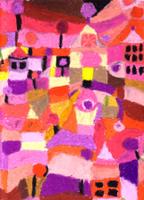 they could be applied. In 1931 he began teaching at Dusseldorf Akademie, but he was dismissed by the Nazis, who termed his work "degenerate." In 1933, Klee went to Switzerland.
they could be applied. In 1931 he began teaching at Dusseldorf Akademie, but he was dismissed by the Nazis, who termed his work "degenerate." In 1933, Klee went to Switzerland.There he came down with the crippling collagen disease scleroderma, which forced him to develop a simpler style and eventually killed him. The late works, characterized by heavy black lines, are often reflections on death and war, but his last painting,
 Still Life (1940; Felix Klee collection, Bern), is a serene summation of his life's concerns as a creator.
Still Life (1940; Felix Klee collection, Bern), is a serene summation of his life's concerns as a creator.
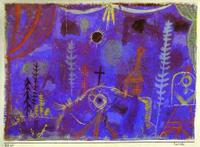
Color possesses me. I don't have to pursue it. It will possess me always, I know it. That is the meaning of this happy hour: Color and I are one. I am a painter.
Paul Klee
Beauty is as relative as light and dark. 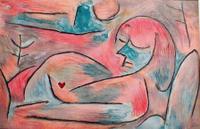 Thus, there exists no beautiful woman, none at all, because you are never certain that a still far more beautiful woman will not appear and completely shame the supposed beauty of the first. Paul Klee
Thus, there exists no beautiful woman, none at all, because you are never certain that a still far more beautiful woman will not appear and completely shame the supposed beauty of the first. Paul Klee
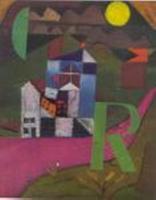
Everything vanishes around me, and works are born as if out of the void. Ripe, graphic fruits fall off. My hand has become the obedient instrument of a remote will. Paul Klee
Have a wonderful Wednesday.
Love,
Suz




Hmmmmmmmmm. From those pictures, it looks like your getting in the mood for a quilt show!
ReplyDeleteMel
duh-*you're*
ReplyDelete